Physical Address
304 North Cardinal St.
Dorchester Center, MA 02124
Physical Address
304 North Cardinal St.
Dorchester Center, MA 02124
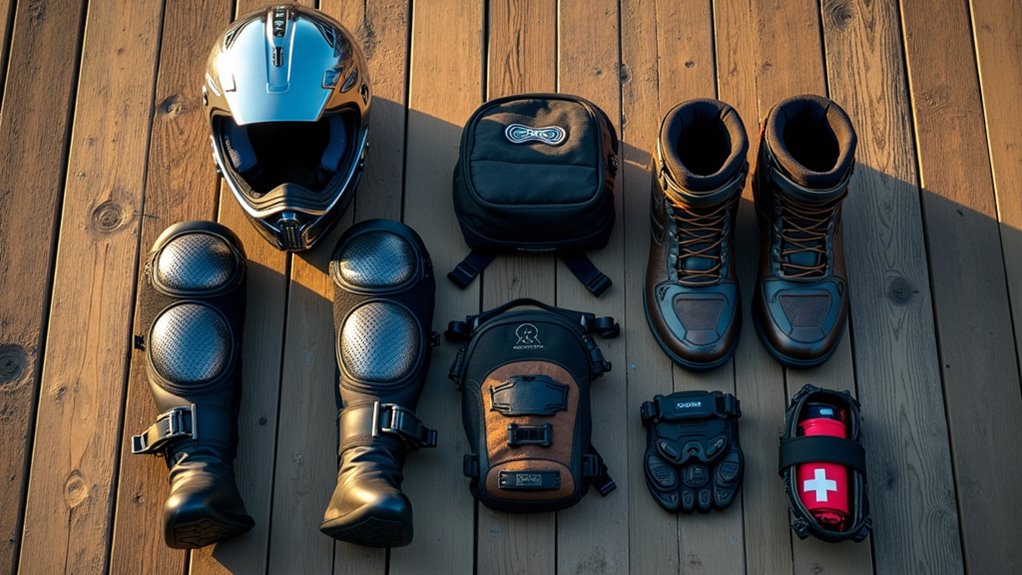
Ignoring these critical dirt bike essentials could turn your dream trail ride into a nightmare—discover what seasoned riders never leave behind.
You’ve probably experienced that sinking feeling when you’re miles deep on a trail and realize you’re missing something vital. Whether it’s your first dirt bike adventure or your fiftieth, being properly equipped can mean the difference between an epic ride and a dangerous situation. The right gear doesn’t just enhance your experience—it could literally save your life when things go sideways in the backcountry.

When you’re tearing through trails at high speeds, the difference between walking away from a crash and ending up in the emergency room often comes down to what you’re wearing.
Your helmet’s your most vital piece of gear—invest in a DOT or Snell-certified model that fits snugly.
Chest protection shields your ribs and organs from rocks and branches, while knee and elbow pads absorb impact during falls.
Don’t skimp on riding boots; they’ll protect your ankles from twisting injuries and provide vital grip on foot pegs.
Gloves improve your grip and protect your hands during slides.
Consider goggles over glasses—they won’t fog up or fall off mid-ride.
Quality gear costs more upfront, but it’s cheaper than hospital bills and recovery time.
Just like family camping requires proper preparation and safety gear, dirt biking demands the same level of attention to protective equipment.
Getting lost on unfamiliar trails can turn an exciting ride into a dangerous situation, especially when you’re miles from civilization with limited daylight. You’ll want reliable navigation tools that won’t fail when you need them most.
A GPS device designed for off-road use is your best bet. Unlike smartphone apps, dedicated GPS units offer longer battery life, better durability, and work without cell service. Download trail maps beforehand and mark key waypoints like parking areas and fuel stops.
Don’t rely solely on technology. Carry a waterproof paper map and compass as backup. Learn basic navigation skills before hitting the trails.
Consider a GPS tracker that lets others monitor your location for added safety during solo rides.
Just as glacier climbing enthusiasts rely on proper navigation equipment to safely traverse challenging icy terrain, dirt bikers need dependable tools to navigate backcountry trails.
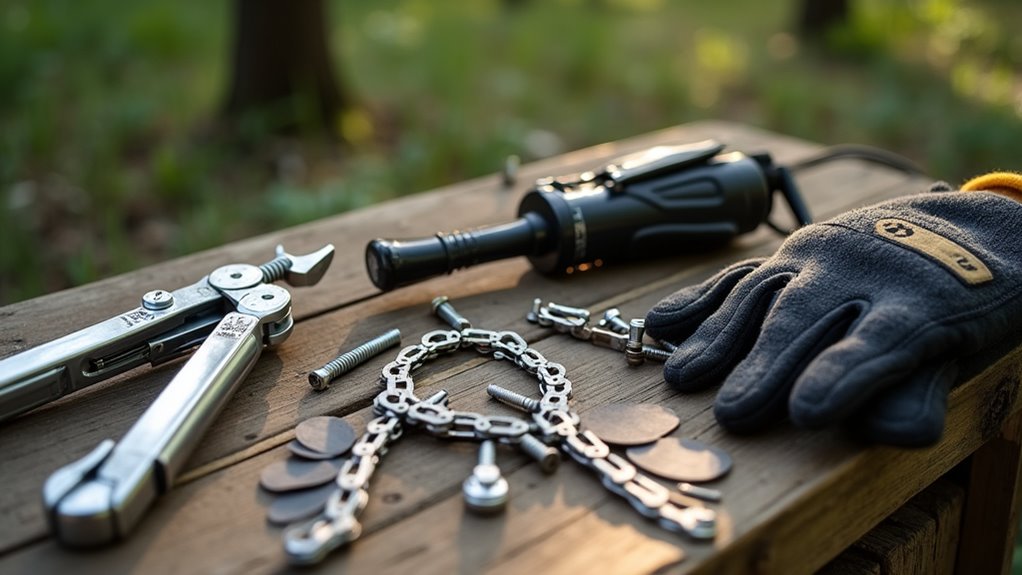
Mechanical failures don’t wait for convenient timing, and you’ll face breakdowns on remote trails where help isn’t readily available. You need a compact emergency repair kit that handles common trail-side problems without weighing you down.
When mechanical failures strike on remote trails, a well-prepared emergency repair kit becomes your lifeline back to civilization.
Pack tire levers, patches, and a portable air pump for puncture repairs. Include zip ties, electrical tape, and JB Weld for quick fixes on broken parts. Carry spare spark plugs, a plug wrench, and a small screwdriver set.
Add safety wire, cable ties, and a multi-tool for versatility.
Keep everything organized in a waterproof bag or tool roll. Consider adding a waterproof sleeping bag to your overnight trail gear for protection against unexpected weather conditions. Practice using these tools at home so you’re not learning during an emergency. The right repair kit means the difference between riding home and walking out.
Since dirt biking demands intense physical exertion in challenging conditions, you’ll burn through energy and fluids faster than you might expect. Pack a hydration pack with at least 70 ounces of water for full-day rides, plus electrolyte tablets to replace lost minerals.
Energy bars, trail mix, and dried fruits provide quick fuel without spoiling in heat.
Don’t rely solely on your bike’s storage – wear a lightweight backpack or chest pack for easy access while riding. Include glucose gels for instant energy boosts during challenging sections.
Plan water refill stops on longer trails, and always carry purification tablets as backup.
Remember: dehydration kills performance and clouds judgment. Stay ahead of thirst, eat small amounts frequently, and listen to your body’s signals.
Just like with festival camping, applying safety precautions for hydration and nutrition becomes even more critical when you’re miles from civilization on remote trails.
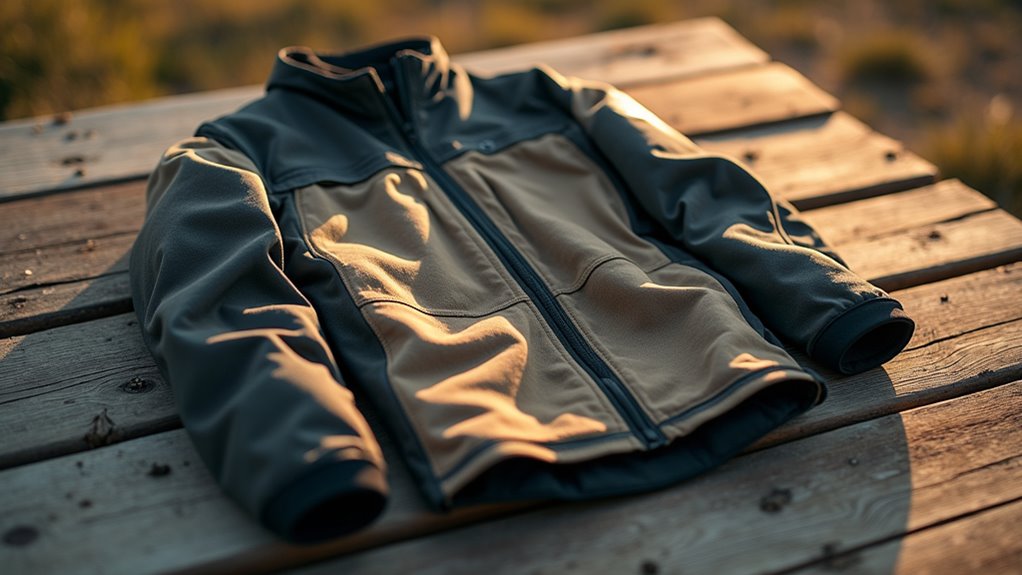
Weather conditions can shift dramatically during dirt bike rides, transforming a sunny morning into a cold, wet afternoon that’ll test both your skills and comfort. You’ll need strategic layering to handle these changes effectively.
Start with moisture-wicking base layers that pull sweat away from your skin. Add an insulating mid-layer like fleece or lightweight down for warmth retention. Your outer shell should be windproof and waterproof while allowing ventilation to prevent overheating.
Don’t forget extremities – waterproof gloves, thermal socks, and a balaclava make huge differences in harsh conditions. Pack a compact rain suit that fits over your gear without restricting movement.
Choose layers you can easily add or remove during stops. This flexibility keeps you comfortable regardless of temperature swings or weather surprises on the trail. When temperatures drop significantly, having proper cold-weather gear becomes essential for maintaining both safety and performance during extended trail rides.
When you’re miles from civilization with no cell towers in sight, reliable communication devices become your lifeline to the outside world. A satellite communicator like a Garmin inReach lets you send SOS signals and text messages even in complete dead zones.
Two-way radios work perfectly for staying connected with your riding group, especially when trails split or someone needs to stop for repairs.
Consider a personal locator beacon (PLB) as backup emergency gear – it’ll transmit your exact GPS coordinates to rescue services with the push of a button.
Ham radios offer extended range communication for serious backcountry riders.
Don’t forget extra batteries or portable chargers, since dead devices won’t help during emergencies. Test everything before you ride.
If you’re planning extended backcountry adventures that might include winter camping, having reliable communication becomes even more critical when weather conditions can change rapidly and create additional hazards.
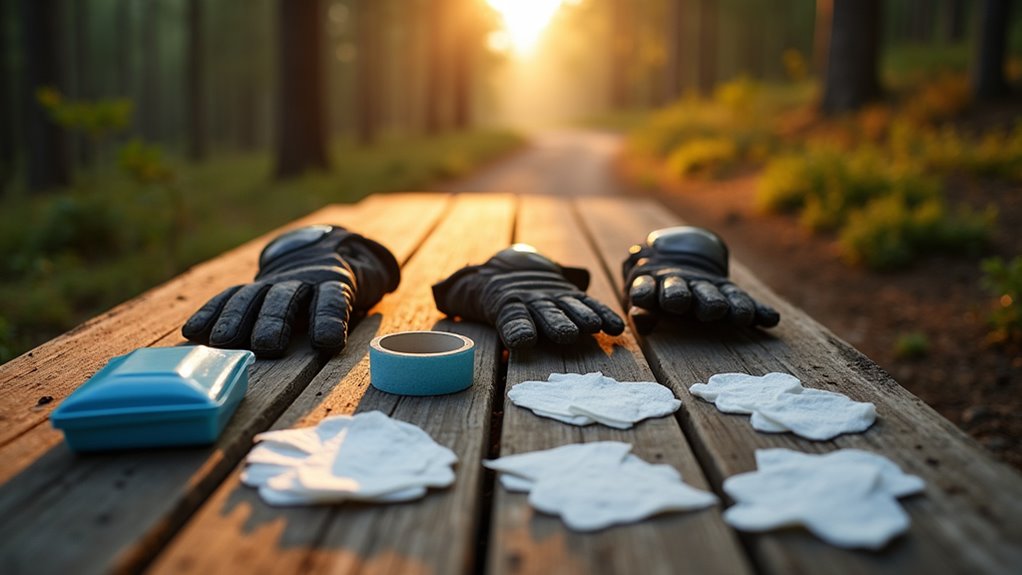
Even though dirt biking gets your adrenaline pumping, crashes and spills are part of the territory – and you’ll want proper first aid supplies when they happen. Pack a compact trauma kit with gauze pads, medical tape, and antiseptic wipes for cuts and scrapes.
Include elastic bandages for sprains and instant cold packs for swelling. Don’t forget pain relievers like ibuprofen and acetaminophen.
You’ll also need nitrile gloves, scissors, and tweezers for splinter removal. Consider adding a triangular bandage for slings and a small bottle of saline solution for cleaning wounds.
Keep everything in a waterproof pouch that’s easily accessible. For extended trail rides, consider putting together a more comprehensive first aid kit that includes additional supplies for handling more serious injuries. Remember, these supplies won’t replace professional medical care, but they’ll help stabilize injuries until you can reach help.
How often have you been miles into a trail ride only to hear the dreaded hiss of air escaping from your tire? Don’t let a puncture end your adventure early. You’ll need a compact tire repair kit containing tire plugs, insertion tools, and rubber cement.
Pack a portable CO2 inflator with extra cartridges – it’s faster than hand pumps when you’re trail-side. Include tire irons for tough bead situations and a pressure gauge to ensure proper inflation.
Heavy-duty zip ties can temporarily secure loose tire beads, while duct tape handles emergency sidewall patches. A small tube of valve core remover prevents stuck cores from ruining your day. These tools transform potential ride-enders into minor inconveniences.
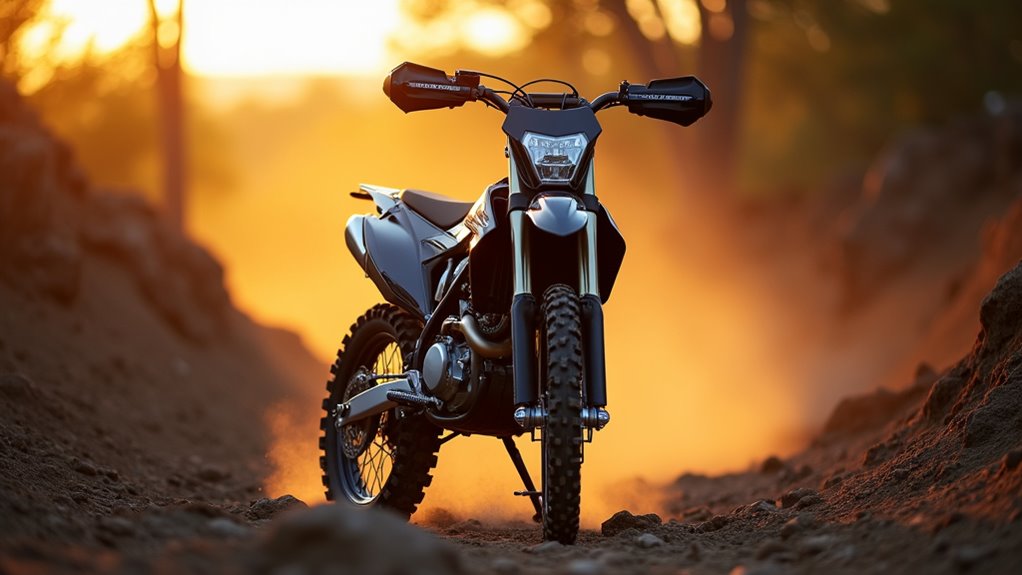
As daylight fades on those epic all-day rides, you’ll quickly realize that proper lighting isn’t just helpful – it’s essential for safety and navigation. A quality LED headlight system should be your first investment, providing bright, focused illumination that cuts through darkness and dust.
Look for units with multiple brightness settings to preserve battery life during slower sections.
Don’t overlook auxiliary lighting options like handlebar-mounted spot lights or light bars for wider coverage. A reliable taillight keeps you visible to fellow riders behind you.
Pack backup lighting solutions too – compact headlamps and flashlights are lifesavers when you need hands-free illumination for repairs or equipment checks. Choose rechargeable options with long battery life, and always carry spare batteries or portable power banks. Just like deciding whether to rent or buy other recreational equipment, consider your riding frequency and budget when investing in lighting gear.
When you’re miles from civilization with gear scattered across your bike, you’ll appreciate having dedicated storage solutions that keep everything secure and accessible. Tank bags offer quick access to essentials like snacks, tools, and your phone while keeping weight centered.
Tank bags keep your most crucial gear within arm’s reach while maintaining your bike’s perfect balance on remote trails.
For longer adventures, tail bags provide generous storage space for spare clothes and camping gear without affecting your bike’s balance.
Waterproof dry bags are non-negotiable for protecting electronics and important items from dust and moisture. Choose bags with compression straps to minimize bulk and prevent shifting during rough terrain.
Frame bags utilize unused space near your bike’s center of gravity, perfect for tools and emergency supplies.
Don’t overlook simple solutions like bungee cords and cargo nets—they’re versatile, lightweight, and surprisingly effective for securing odd-shaped items.
If you’re planning to ride in wet conditions, ensure your storage solutions have proper sealing and consider double-bagging critical items for extra protection.
You’re now equipped with the trail essentials that’ll keep you safe and prepared for any adventure. Here’s something that might surprise you: studies show that 78% of dirt bike accidents could’ve been prevented with proper protective gear and preparation. Don’t become part of that statistic. Pack your emergency kit, strap on that certified helmet, and hit the trails with confidence. Your preparation today determines whether you’ll have epic stories or expensive hospital bills tomorrow.